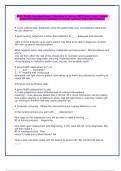SLCC Health Assessment Exam 1 | Questions & Answers (100 %Score) Latest Updated
2024/2025 Comprehensive Questions A+ Graded Answers | With Expert Solutions
A nurse collects data. Subjective (what the patient tells you) and objective (data/facts
we can observe)
A good nursing judgement is when data collection is ___ - Adequate and accurate
-able to know and pick up on signs patient may have to be able to diagnose correctly.
Will then be able to educate patient.
What happens when data collected is inadequate and inaccurate? - Miscalculations and
errors
-this will then affect the rest of the phases due to incorrect nursing judgement.
examples, incorrect diagnoses, planning, implementation, and evaluation.
-Avoid leading to ineffective patient care, injuries, and possible death
A good health assessment is (1-4)
1. ____and ___. examples?
2. - 1) -ongoing and -continuous
examples: call light close to patient, bed railing up or down, any distractors, anything to
cause fall risk.
2)Analyze and synthesize data.
A good health assessment is also
3. make judgements about effectiveness of nursing interventions
meaning? - if we discover patient has a fall risk. As a nurse intervention will be making
sure patient doesn't go to bathroom alone. Has call light close in case they need to get
up, nothing on the floor that may cause potential fall
4. Evaluate outcomes - Where the interventions put in place affective or not.
In the nursing process you start with __ - Assessment
Now base on the assessment you will be able to make a nursing ___
#2 of nursing process. - diagnosing
Now base upon assessment and diagnosing. In this case fall risk is the diagnoses. We
will then make a __
#3 of nursing process - Plan
-ways to make sure patient doesn't fall
Once a plan has been made with the patient to avoid a fall. We will then be able to
_____
,#4 of nursing process - Implement
-put things into practice
#5 of nursing process is - evaluation
-evaluate everything that has been done so far. Is the plan working or not working?
Which two in nursing process are ongoing processes and separate phases along the
way. Going back and fourth. - we are ALWAYS doing
Assessment and
evaluation
What are the types of assessments? - Initial Comprehensive
ongoing
Focused
emergency
Which type of assessment?
Type when we first meet patient. any environment (nursing home, hospital). Collect ALL
data. subjective-client's perception of his/her health of all body parts or systems.
Collection of objective data gathered during step by step physical examination. Evaluate
the client's health status to identify functional health patterns that are problematic, and
to establish baseline data against which future health status changes can be measured
and compared.
-FH, PMH, SH - Initial Comprehensive Assesment
Which type of assessment?
-quick priority assessment. going over key steps.
Data collection that occurs after the comprehensive database is established. performed
wherever and whenever the nurse, or another health care professional has an
encounter with the client. - ongoing assessment
what type of assessment?
-might see in the clinic
A thorough assessment of a particular client problem and does not address areas not
related to the problem. This type of assessment has a narrower scope and a shorter
time frame than the initial assessment. Nurses determine whether the problems still
exists and whether the status of the problem has changed, improved, worsened,
resolved - Focussed assessment
Which type of assessment?
is a very rapid assessment performed in life-threatening situations. Immediate
assessment is needed to provide prompt treatment. - emergency assessment.
Which type of assessment?
Patient is is either choking, cardiac arrest, drowning. Airway, breathing, circulatory
involved. - Emergency assessment
, What type of assessment?
patient comes in for stitches for finger
or
a cut on hand
or earache - Focus Assessment
What type of assessment?
lung cancer requires frequent assessment of respiratory rate, oxygen saturation, lung
sounds, skin color, and cap refill - Ongoing assessment
Subjective data includes - Sensations or symptoms
(pain, hunger)
Feelings,
(happiness, sadness)
perceptions
desires
preferences
beliefs
ideas
values
personal information
client interview "how to collect subjective data" - Biographical information
(name age religion)
history of present illness: physical symptoms related to each body part or system.
personal health history
term-22family history
health and lifestyle practices
(nutrition, activity, relationships, cultural beliefs or practices, family structure and
function, community environment)
review of system
Objective data includes - physical characteristics
(skin color, posture)
body functions
(heart rate, RR,)
appearance
(dress, hygiene)
behavior
(mood, affect)
measurements
(blood pressure, temp, height, weight)
lab results




